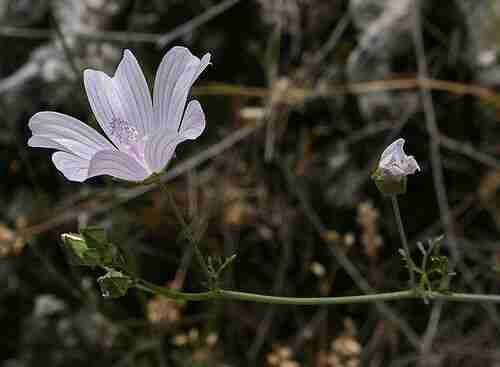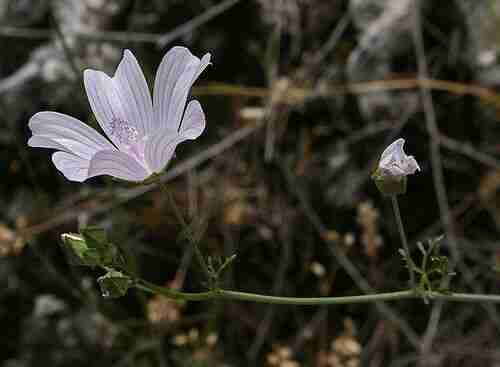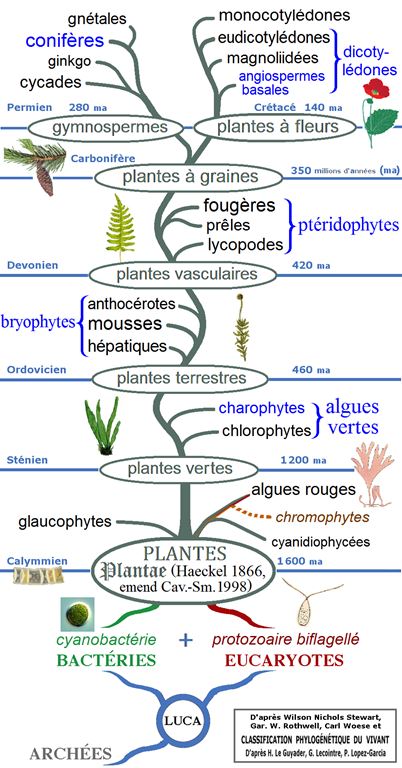Pas d'autre illustration
pour le moment 😕
Classification
- Classique : en haut de l\'écran, sous le coeur.
- Phylogénétique :
- Clade 4 : Angiospermes ;
- Clade 3 : Dicotylédones_vraies ;
- Clade 2 : Rosidées ;
- Clade 1 : Malvidées ;
- Ordre APN : Malvales ;
- Famille APN : Malvaceae ;
Illustration : cet arbre phylogénétique des plantes montre les principaux clades et groupes traditionnels (monophylétiques en noir et paraphylétiques en bleu).
Dénominations
✖- Nom botanique : Malva tournefortiana L. (1755)
Description et culture
✖- dont infos de "FOOD PLANTS INTERNATIONAL" :
Description :
Une herbe{{{0(+x) (traduction automatique).
Original : A herb{{{0(+x).
 Consommation (rapports de comestibilité, parties utilisables et usages alimentaires correspondants)
Consommation (rapports de comestibilité, parties utilisables et usages alimentaires correspondants)
✖
Feuille (jeunes pousses et feuilles{{{8 [nourriture/aliment{{{(dp*)(8)]) comestible.(1*)
Détails : Jeunes pousses et feuilles consommées en Europe depuis les anciens Grecs et Romains{{{8 (ex. : cuites comme potherbe{{{(dp*)).(1*)
Partie testée :
/| Taux d'humidité | Énergie (kj) | Énergie (kcal) | Protéines (g) |
|---|---|---|---|
| / | / | / | / |
| Pro- vitamines A (µg) |
Vitamines C (mg) | Fer (mg) | Zinc (mg) |
| / | / | / | / |
 Risques et précautions à prendre
Risques et précautions à prendre
✖
(1*)ATTENTION : bien que nous ayons vu aucun rapport de toxicité pour cette espèce, lorsqu'elles sont cultivées sur des sols riches en azote (et en particulier lorsque ceux-ci sont cultivés inorganiquement), les feuilles de certaines espèces ont tendance à concentrer des niveaux élevés de nitrates dans leurs feuilles{{{5(+) ; les feuilles sont parfaitement saines à tout autre moment{{{(dp*)(5(+x)).
Galerie(s)
✖
Par Manuel M. Ramos, via flickr
Autres infos
✖dont infos de "FOOD PLANTS INTERNATIONAL" :
Distribution :
C'est une plante de climat méditerranéen{{{0(+x) (traduction automatique).
Original : It is a Mediterranean climate plant{{{0(+x).
Localisation :
Espagne{{{0(+x) (traduction automatique).
Original : Spain{{{0(+x).
Liens, sources et/ou références
✖Sources et/ou références :
Tela Botanica ; INPN ; FloreAlpes ; L'herbiel de Gabriel ; Wikipedia (en espagnol) ;
dont classification : "The Plant List" (en anglais) ; "GRIN" (en anglais) ; ;
dont livres et bases de données : 8Le régal végétal : plantes sauvages comestibles (livre pages 293 à 294, par François Couplan, éditions Ellebore) ;
Sauvages & comestibles - herbes, fleurs et petites salades (de Marie-Claude Paume, éditions EDISUB, 2011) / détails du livre ; CDV
dont biographie/références de "FOOD PLANTS INTERNATIONAL" :
Altschul, S.V.R., 1973, Drugs and Foods from Little-known Plants. Notes in Harvard University Herbaria. Harvard Univ. Press. Massachusetts. no. 2738 ; Ambasta, S.P. (Ed.), 2000, The Useful Plants of India. CSIR India. p 352 ; Bandyopadhyay, S. et al, 2009, Wild edible plants of Koch Bihar district, West Bengal. Natural Products Radiance 8(1) 64-72 ; Blamey, M and Grey-Wilson, C., 2005, Wild flowers of the Mediterranean. A & C Black London. p 132 ; Bodkin, F., 1991, Encyclopedia Botanica. Cornstalk publishing, p 671 ; Facciola, S., 1998, Cornucopia 2: a Source Book of Edible Plants. Kampong Publications, p 148 ; Flora of Pakistan. www.eFloras.org and Flora of China. www.eFloras.org ; Goode, P., 1989, Edible Plants of Uganda. FAO p 54 ; Hedrick, U.P., 1919, (Ed.), Sturtevant's edible plants of the world. p 400 ; Hu, Shiu-ying, 2005, Food Plants of China. The Chinese University Press. p 542 ; Ju, Y., et al, 2013, Eating from the wild: diversity of wild edible plants used by Tibetans in Shangri-la region, Yunnan, China, Journal of Ethnobiology and Ethno medicine 9:28 ; Kays, S. J., and Dias, J. C. S., 1995, Common Names of Commercially Cultivated Vegetables of the World in 15 languages. Economic Botany, Vol. 49, No. 2, pp. 115-152 ; Khasbagan, Hu-Yin Huai, and Sheng-Ji pei, 2000, Wild Plants in the Diet of Athorchin Mongol Herdsmen in Inner Mongolia. Economic Botany 54(4): 528-536 ; Manandhar, N.P., 2002, Plants and People of Nepal. Timber Press. Portland, Oregon. p 309 ; Plants For A Future database, The Field, Penpol, Lostwithiel, Cornwall, PL22 0NG, UK. https://www.scs.leeds.ac.uk/pfaf/ ; Rana, J.C. et al, 2011, Genetic resources of wild edible plants and their uses among tribal communities of cold arid regions of India. Genetic Resources and Crop Evolution. 59:135-149 ; READ, ; Ruffo, C. K., Birnie, A. & Tengnas, B., 2002, Edible Wild Plants of Tanzania. RELMA p 450 ; Schneider, E., 2001, Vegetables from Amaranth to Zucchini: The essential reference. HarperCollins. p 379 ; Singh, H.B., Arora R.K.,1978, Wild edible Plants of India. Indian Council of Agricultural Research, New Delhi. p 28 ; Sp. pl. 2:689. 1753 ; Tang ya, Malvaceae. Flora of China. Vol. 12 p 266 ; Terra, G.J.A., 1973, Tropical Vegetables. Communication 54e Royal Tropical Institute, Amsterdam, p 57 ; Valder, P., 1999, The Garden Plants of China. Florilegium. p 374 ; Wujisguleng, W., & Khasbagen. K., 2010, An integrated assessment of wild vegetable resources in Inner Mongolian Autonomous Region, China. Journal of Ethnobiology and Ethnomedicine 6:34
Recherche de/pour :
Espèces du même genre (Malva)
✖22 taxons
- Malva alcea L. (Mauve alcée)
- Malva arborea (L.) Webb & Berthel. (Mauve royale)
- Malva australiana
- Malva cretica Cav. (Mauve de Crète)
- Malva durieui Spach
- Malva meluca
- Malva mohileviensis
- Malva moschata L. (Mauve musquée)
- Malva multiflora (Cav.) Soldano (Lavatère de Crète)
- Malva neglecta Wallr. (Mauve commune)
- Malva nicaeensis All. (Mauve de Nice)
- Malva parviflora L. (Mauve à petites fleurs)
- Malva pusilla Sm. (Mauve à petites feuilles)
- Malva rotundifolia
- Malva sinensis
- Malva sp
- Malva subovata (DC.) Molero & J.-M. Monts. (Lavatère d'Espagne)
- Malva sylvestris L. (Mauve sylvestre)
- Malva tournefortiana L. (Mauve de Tournefort)
- Malva verticillata L. (Mauve crépue)
- Malva x intermedia Boreau (Mauve)
- Malva x zoernigii Fleischm. (Mauve)
Espèces de la même famille (Malvaceae)
✖50 taxons (sur 686)
- Abelmoschus angulosus
- Abelmoschus caillei (A.Chev.) Stevels (Gombo ouest-africain)
- Abelmoschus crinitus Wall.
- Abelmoschus esculentus (L.) Moench (Gombo)
- Abelmoschus ficulneus (L.) Wight & Arn. (Ketmie faux ficus)
- Abelmoschus manihot (L.) Medik (Aibika)
- Abelmoschus mauritianum (Jacq.) Medic.
- Abelmoschus moschatus Medik (Ambrette)
- Abelmoschus pannosum (Forst. f.) Schlechtend.
- Abroma angusta (L) Willd.
- Abutilon angulatum (Guill. & Perr.) Mast.
- Abutilon cabrae De Wild. et Th.Dur.
- Abutilon fruticosum Guill. & Perr.
- Abutilon glaucum (Cav.) Sweet
- Abutilon grandifolium (Willd.) Sweet
- Abutilon hirtum (Lam.) Sweet
- Abutilon indicum (L.) Sweet (Mauve pays)
- Abutilon leucopetalum (F. Muell.) Benth.
- Abutilon longicuspe Hochst. ex A. Rich.
- Abutilon mauritianum (Jacq.) Medic.
- Abutilon megapotamicum (Spreng.) A. St.-Hil. & Naudin. (Abutilon grimpant)
- Abutilon ochsenii
- Abutilon otocarpum F.Muell.
- Abutilon pannosum (Forst. f.) Schlechtend.
- Abutilon pictum Gillies. ex Hook. & Arn.) Walp. (Abutilon strié)
- Abutilon purpurascens
- Abutilon ramosum (Cav.) Guill. & Perr.
- Abutilon species
- Abutilon theophrasti Medik. (Abutilon d'avicenne)
- Abutilon vitifolium
- Abutilon x hybridum hort. ex Siebert. & Voss. (Lanterne chinoise)
- Abutilon x milleri auct./hort. (Abutilon Miller)
- Abutilon x suntense
- Adansonia digitata L. (Baobab)
- Adansonia grandidieri Baill. (Baobab de grandidier)
- Adansonia gregorii
- Adansonia madagascariensis
- Adansonia perrieri
- Adansonia suarezensis
- Adansonia za
- Alcea apterocarpa
- Alcea flavovirens
- Alcea hohenacheri
- Alcea kurdica
- Alcea pallida
- Alcea rosea L. (Rose trémière)
- Alcea rugosa
- Alcea setosa
- Althaea armeniaca
- Althaea officinalis L. (Guimauve officinale)
- ...



